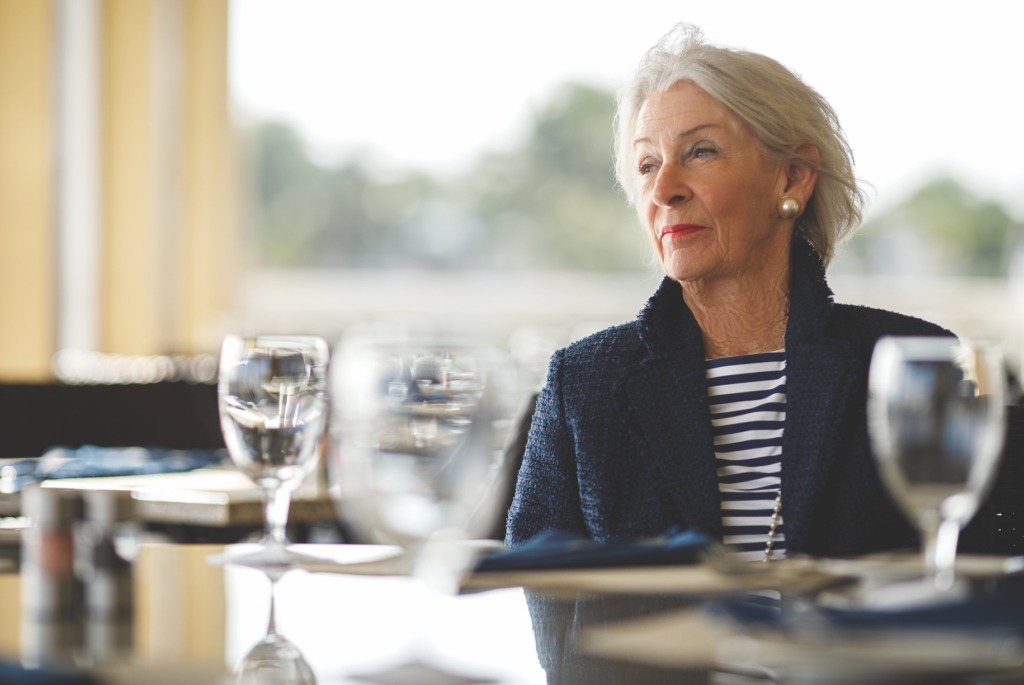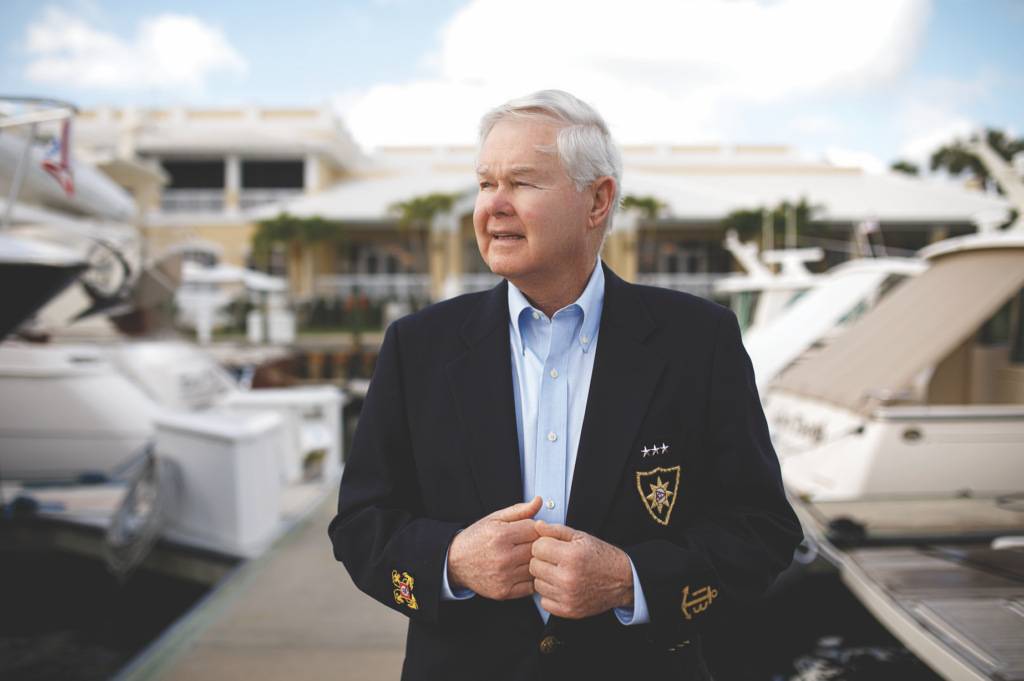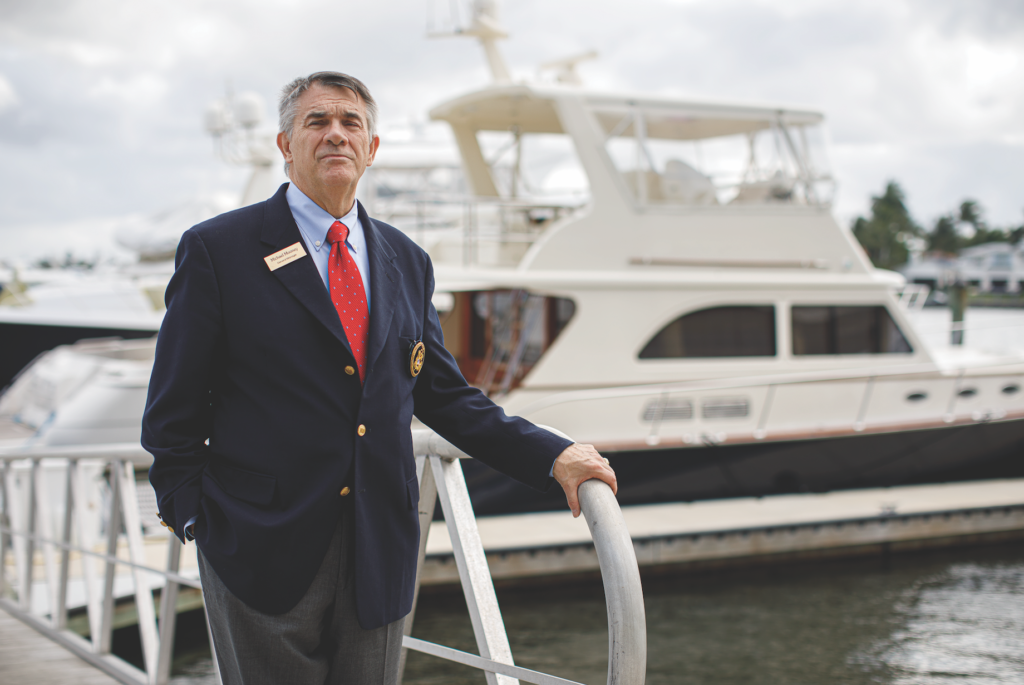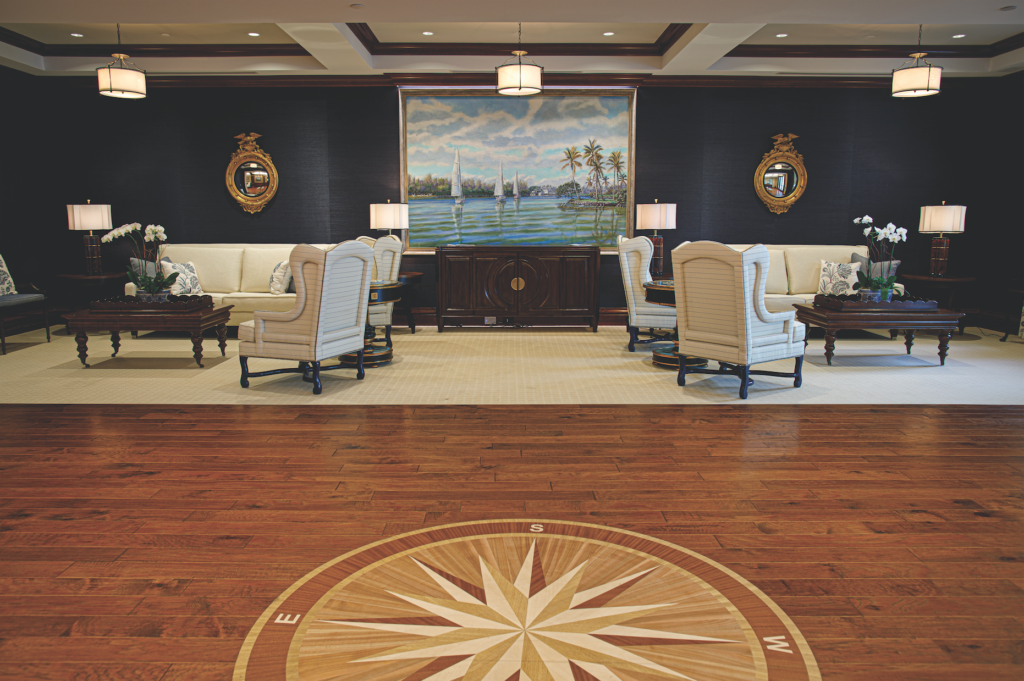The rumors are out there. “Naples Yacht Club has a 10-year wait list,” one narrated boat tour alleges as it cruises past the clubhouse. “You can only get in if someone in your family is already a member.” “It costs $250,000 to join.” Regardless of their accuracy (hint: none of the above is true), Naples Yacht Club carries the kind of cache that elicits whispers and, sometimes, untruths.
Part of the reason for the lore is the yacht club’s reputation: As the oldest private club in Naples, the membership roster is accomplished, to say the least, with more than a few CEOs, politicians and philanthropists. Take one step inside through the grand entrance, and it’s evident this is a special place. A wood compass rose inlay adorns the hand-scraped hickory flooring of the expansive entry. Sunlight trickles through the round porthole windows in the clerestory above, lending a below-deck ambiance. And through the floor-to-ceiling panoramic windows: sweeping views of picturesque Naples Bay.

Today, the whispers surround the clubhouse’s recent $10.4 million renovation, which added nearly 7,000 square feet to the original footprint and transformed the space into a bright and handsome gathering place for some of Naples’ elite. Though the yacht club’s classic character has remained constant, change is inevitable for a private club ranked among the top 50 in the world, and the 2019 transformation is perhaps the most significant in Naples Yacht Club’s history. Gone are the final remnants of the original 1960s-era building; in its place stands an elegant 35,000-square-foot space, resplendent with Old Florida-style architecture and high seas-inspired decor.
One piece of the former clubhouse remains: a giant mural that depicts Naples Bay, Keewaydin Island and the 1960s waterfront. Renowned artist Paul Arsenault painted the scene as a nod to the club’s deep-seated place in local history. Previously installed in an upstairs dining room, the mural became a centerpiece of the recent redesign when the team at Peacock + Lewis, the Naples architecture and interior design firm assigned to the project, suggested dividing it into three sections and rehoming it in main-level areas to maximize exposure. Arsenault oversaw the weeks-long task—and it was just the thing needed to carry old into new. The mural anchors the space with an undeniable pride of place. So, what really goes on behind those solid mahogany doors? The answer, it turns out, is a whole lot of fun and camaraderie, peppered with the kind of revered traditions that come with more than 70 years of history.
Lynne Shotwell, a Naples resident for 30 years, has been a member of Naples Yacht Club for most of that time, and her parents were members before that. Her earliest memories of the yacht club involve dinners in the restaurant and gatherings over cocktails. “I remember my father wanted to get into Naples Yacht Club desperately, but there was a waitlist at the time,” she recalls. “They were really boaters and fishermen; it wasn’t just social. People gathered here because they loved boating and the camaraderie.” Close relationships were formed, but important work was done, too—work that would shape the future of the Naples community.


In the case of “which came first”—Naples or Naples Yacht Club—the club laid its roots first in 1947, two years before Naples was incorporated as a city. Beyond the official matters, the city owes much of what it is today to the very same people who formed the club.
Naples pioneers Stephen Briggs, Benjamin Morris and John Glen Sample first visited in the 1930s and promptly fell in love with the area. They began buying land at the south end of town. Back then, all the area had to show for itself was a shell pit and a fishing camp at Gordon Pass. Now, that land goes by a different moniker: Port Royal. (Sample reportedly purchased around two square miles, which cost him $54,000.)
Among the friends’ first order of business: establish a club to celebrate the traditions of the water they so loved. But with other business ventures in the works for the three founders— the sole members for the club’s first six years—construction of a clubhouse would have to wait. Instead, Naples Yacht Club gatherings took place on an unusual-looking boat called the Mangrove King, which sported picnic tables on the foredeck and palm trees at the aft.

When they weren’t on the water, Briggs, Morris, Sample and their families were helping to shape the city. Bea Briggs, Stephen’s wife, was instrumental in establishing the Naples Community Hospital, rallying a group of friends to raise $500,000 to kickstart its construction, and hosting white elephant sales on the front lawn of her Gordon Drive home.
Then and now, a philanthropic spirit remains an important part of the Naples Yacht Club legacy. “It was a nucleus of people that got together,” Shotwell recalls. “They formed a bond here and carried that out into the community. Everybody pitched talent and money, and it got done.” Another such venture? The Conservancy of Southwest Florida, of which Shotwell’s father, Elmer Wavering, was a founding member. His altruism is a legacy Shotwell continues today—and one which is shared by many club members, who collectively make significant contributions to local and national nonprofit organizations each year.

But a sense of goodwill isn’t the only constant through the years. Traditions hold so strong that they’re part of the motto: “Honoring traditions, committed to excellence.”
“Yacht clubs are different than country clubs,” says Michael Mooney, the club’s general manager. “At yacht clubs, tradition is what they live and breathe. Part of their DNA is rooted in military traditions, and that will never change.” That time-honored reverence is most evident during events such as the annual Fleet Review, a parade of yachts dressed in nautical flags during which members sport classic yacht club insignia. The gathering has taken place at Naples Yacht Club every year since 1947. “It’s like an old Fourth of July in a little, Midwest town,” Shotwell adds. “It just grabs your heartstrings.”
Perhaps it’s for all these reasons that the yacht club continues to foster mystery and speculation. Another misnomer: You have to be a boater to belong. Though a small majority of members are boat owners, the invitation-only club offers a range of activities, including a robust calendar of social events, a speaker series, bocce tournaments on the lawn, a car club and even its own wine society. This “club within a club” concept allows people to form bonds through shared interests and it underlies the heart of Naples Yacht Club: its friendships. To join, new members typically have to be recommended by someone within the group and approved by everyone.


“The yacht club has not grown at the same pace as the city, and that’s been on purpose,” says Bill Mowry, a 21-year member and former club commodore, a position akin to a board president. Despite significant development just outside the club’s doors, most members insist that when it comes to the things that matter—the spirit and principles of the club—not much has changed at all. “Even though we have a new clubhouse, this is not a new club. It’s the same old club we’ve always enjoyed,” Mowry adds.
As they have been for decades, Naples and its first private club also remain inextricably linked. “The town and the club have become more sophisticated since their early days, but they’ve both kept their charm and small-town feel,” says Brenda O’Connor, the club’s executive director of membership. “Camaraderie on the waterfront and a sense of belonging are still at our core. Even during season in Naples, everybody knows each other, and that’s how it is at the club.”






